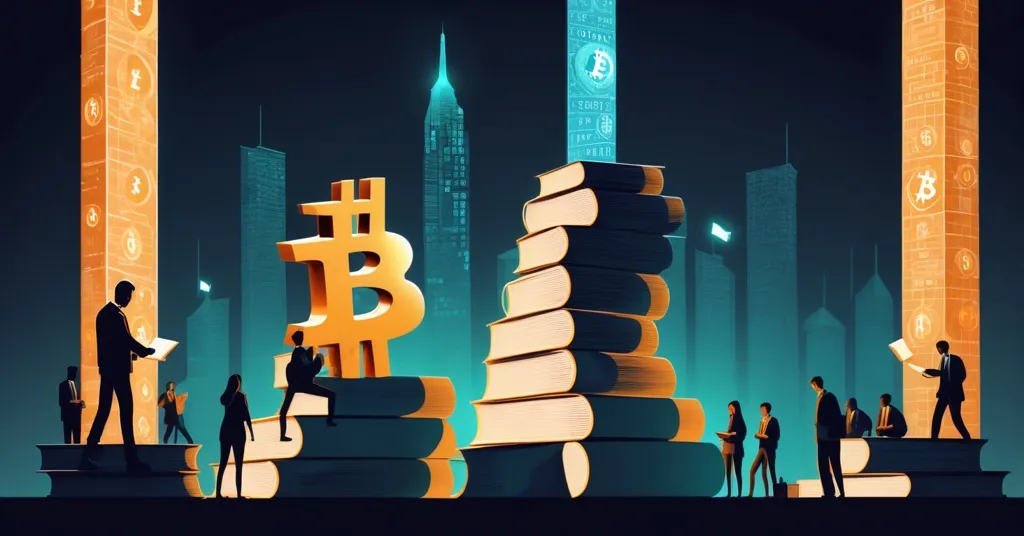Trump’s $1.6T Student Loan Privatization: Crisis or DeFi Opportunity?

Trump’s Plan to Privatize $1.6 Trillion Student Loan Portfolio: A Crisis or Opportunity for Decentralized Finance?
The Trump administration is stirring the pot with a audacious proposal to offload parts of the staggering $1.6 trillion federal student loan portfolio to private investors, impacting 45 million Americans. Reported by Politico, this move targets the “high-performing” chunks of debt and aligns with a broader agenda to slash the federal government’s role in lending. But as borrower protections hang in the balance, could decentralized technologies like blockchain and Bitcoin offer a radical alternative to this looming financial shake-up?
- Debt Sale on the Table: Targeting “high-performing” segments of the $1.6 trillion student loan portfolio for privatization.
- Policy Shift: Reflects Trump’s push to shrink federal oversight, possibly moving loans to the Treasury or dismantling the Education Department.
- Crypto Potential: Could blockchain and Bitcoin challenge both federal and private debt systems with transparency and autonomy?
The Privatization Push: A Bold Gambit
For months, officials from the Education and Treasury Departments have been hashing out plans to sell off portions of the federal student loan portfolio, a mammoth pool of debt owed by millions who borrowed for education. The focus is on “high-performing” loans—those with low default rates and steady repayments—that would be enticing to private investors looking for safe returns. Federal law permits such sales, but only with Treasury approval and a guarantee that taxpayers won’t get shafted. During Trump’s first term, consulting firms flagged that the portfolio’s value was lower than government estimates, suggesting a potential discount sale if push comes to shove.
This isn’t just about trimming fat. Trump has long championed reducing the government’s footprint, and student loans are a prime target. There’s chatter about transferring the entire portfolio from the Education Department to the Treasury—a shift that could mean less focus on borrower welfare and more on fiscal metrics. Trump’s pledge to outright eliminate the Education Department adds a political edge to the debate. A senior official told Politico:
“The Trump administration is committed to analyzing all aspects of the federal student loan portfolio. Unlike the previous administration, we are focused on ensuring the long-term health of the portfolio for the benefit of both students and taxpayers.”
Sounds like a win for fiscal responsibility, right? But the reality bites hard: unloading debt to private hands could be a jackpot for Wall Street and a disaster for borrowers. Let’s unpack why.
Borrower Fallout: What’s Really at Stake?
The federal student loan system, for all its flaws, offers critical safety nets. Take Income-Based Repayment (IBR), a plan that ties monthly payments to your earnings, making debt manageable for those in lower-income jobs. Then there’s forgiveness programs, which can wipe out remaining balances after 20-25 years of consistent payments. These protections are lifelines for millions—especially with student debt outpacing inflation and wages, averaging over $37,000 per borrower according to recent data from the Federal Reserve.
Private lenders? They don’t play by the same rules. If your loan gets sold off, those forgiving terms could vanish faster than a Bitcoin pump-and-dump scheme. Harsher repayment schedules, higher interest rates, and zero forgiveness options might become the new normal. Picture this: a teacher with $50,000 in loans, paying under IBR, suddenly faces a private lender demanding double the monthly amount with no end in sight. That’s not just stress—that’s a financial death spiral.
Trump’s team hasn’t minced words or actions. They’ve already axed most Biden-era forgiveness initiatives, restarted collections on defaulted loans (paused since March 2020 due to the pandemic), and temporarily halted IBR forgiveness. Higher education expert Mark Kantrowitz highlighted the gut punch this delivers:
“That’s because IBR is the only income-driven repayment plan still available that leads to loan erasure.”
Compounding the chaos, Trump’s allies in Congress passed a bill scrapping multiple repayment plans, leaving borrowers with fewer escape routes. With privatization looming, the risk isn’t just theoretical—it’s a ticking time bomb for 45 million Americans.
Privatization: Efficiency or Exploitation?
Let’s give credit where it’s due. Supporters of privatization argue it could streamline a clunky federal system. Offloading “high-performing” loans might bring in quick cash, cut administrative bloat, and shrink the deficit. If structured right, it could offload some burden from taxpayers who indirectly shoulder default risks. Think of it as the government passing the hot potato to private players better equipped for risk management.
But here’s the flip side—and it’s a big one. Private investors aren’t running a charity. They cherry-pick the best loans, leaving the government stuck with the riskiest, most default-prone debt. That’s a raw deal for taxpayers if defaults spike. And for borrowers, it’s a potential horror show: profit-driven lenders could jack up rates or enforce draconian terms. History offers a cautionary tale—look at Sallie Mae, originally a government entity, which after privatization in the early 2000s became notorious for aggressive collection tactics. Efficiency sounds great until you’re the one squeezed dry. For more details on the current proposal, check out the report on the Trump administration’s plan to privatize parts of the $1.6 trillion student loan portfolio.
The Crypto Alternative: Can Decentralization Save the Day?
While Trump’s privatization plan sparks heated debate, it’s worth asking: could decentralized finance (DeFi) offer a third path? The student debt crisis reeks of centralized system failures—opaque terms, bureaucratic red tape, and now the threat of predatory private hands. Blockchain technology, the backbone of cryptocurrencies like Bitcoin and Ethereum, champions transparency and autonomy. So, how could it disrupt this broken lending model?
Enter smart contracts, self-executing agreements coded on platforms like Ethereum. Imagine a student loan issued via a smart contract: repayment terms are transparent, immutable, and automatically adjust based on income data fed through a secure oracle. No shady middlemen, no sudden term changes by a greedy lender. If your income drops, the contract lowers payments instantly—no begging a bank for mercy. Projects like Aave and Compound already enable decentralized lending in the crypto space, proving the tech isn’t sci-fi fantasy. They’ve facilitated billions in loans without traditional intermediaries, though mostly for crypto collateral so far.
Bitcoin plays a different role. With inflation eroding purchasing power—U.S. inflation hit 3.2% in 2023 per the Bureau of Labor Statistics—student debt burdens grow heavier in real terms. Bitcoin, often dubbed “digital gold,” has risen over 300% in the past five years, outpacing inflation by a mile. For borrowers, holding even small amounts of BTC could act as a hedge, preserving wealth against a devaluing dollar and offsetting debt stress. Of course, volatility is the catch—BTC’s price swings make it a risky bet for the faint-hearted.
But let’s not drink the Kool-Aid just yet. DeFi isn’t ready for mainstream student lending. Scalability issues plague Ethereum, with transaction fees (gas costs) sometimes spiking to absurd levels. Adoption is another hurdle—most borrowers aren’t crypto-savvy, and regulators are itching to clamp down on DeFi’s wild west. Plus, tokenized debt or smart contract loans lack legal frameworks in most jurisdictions. Still, the ethos of decentralization—cutting out bloated intermediaries and empowering individuals—mirrors the very freedoms Bitcoin maximalists (like myself, admittedly) hold dear. Ethereum’s DeFi ecosystem might outshine Bitcoin for practical lending solutions, even if BTC remains the ultimate store of value.
Looking Ahead: Policy Battles and Innovative Horizons
The Trump administration’s flirtation with privatizing student loans is a high-stakes chess move. On one side, it’s a stab at fiscal pruning and market-driven efficiency; on the other, it risks tossing millions of borrowers into a predatory jungle with no lifeline. Taxpayer interests are supposedly safeguarded by law, but the devil’s in the execution—past privatization flops don’t inspire confidence. Meanwhile, recent policy shifts like resuming collections and pausing forgiveness signal a rough road ahead for debt-strapped Americans.
As this unfolds, the principles of decentralization whisper a provocative question: why settle for tweaking a broken system when you can rebuild it from the ground up? Blockchain lending and Bitcoin’s inflation resistance are speculative today, but they spotlight a glaring truth—centralized financial systems often prioritize power over people. Whether DeFi rises to challenge student debt or not, the $1.6 trillion crisis is a stark reminder that innovation, not just policy, must shape the future of finance.
Key Questions and Takeaways
- What is the Trump administration’s student loan privatization plan?
It involves selling “high-performing” parts of the $1.6 trillion federal student loan portfolio to private investors, aiming to reduce the government’s role in lending. - How could privatization affect student loan borrowers?
It might strip away federal protections like income-based repayment and forgiveness, exposing borrowers to harsher terms from profit-focused private lenders. - Can blockchain technology address the student debt crisis?
Potentially, through smart contracts on Ethereum that automate transparent loan terms, cutting out middlemen. Projects like Aave show DeFi’s promise, though scalability and adoption remain barriers. - Why might Bitcoin help borrowers facing debt burdens?
As an inflation hedge, Bitcoin’s value growth could offset the real cost of debt over time, though its volatility poses risks for conservative investors. - What are the risks of privatizing federal student loans?
Taxpayers could be left with riskier loans while borrowers face tougher repayment conditions. Historical privatization efforts, like Sallie Mae, warn of predatory outcomes.



